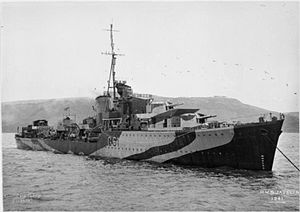| Battle off Zuwarah | |||||||
|---|---|---|---|---|---|---|---|
| Part of the Mediterranean theatre of World War II | |||||||
 HMS Javelin (1941) | |||||||
| |||||||
| Belligerents | |||||||
|
|
| ||||||
| Commanders and leaders | |||||||
|
|
| ||||||
| Strength | |||||||
| 2 destroyers |
6 minesweepers 1 trawler 1 patrol boat 1 pump boat | ||||||
| Casualties and losses | |||||||
| 7 wounded |
180 killed 6 minesweepers sunk 1 trawler sunk 1 patrol boat sunk 1 pump boat sunk | ||||||
| Battle of the Mediterranean | |
|---|---|
1940
1941
1942
1943
1944 1945 | |
| ¹ — Involved an Allied convoy or delivery mission ² — Involved an Axis convoy or delivery mission |
The Battle off Zuwarah (19/20 January 1943) was a naval night encounter during the Second World War. The battle took place in Libyan waters between the Royal Navy and the Regia Marina. An Italian flotilla of small minesweepers and auxiliary vessels evacuating Tripoli was destroyed by two British destroyers.
Background
On 15 January 1943, Kelvin and HMS Nubian, blockading the port of Tripoli in Libya, had forced the Italian torpedo boat Perseo to retire damaged and then sunk the 4,537 Gross register tonnage (GRT) D'Annunzio, a merchant ship trying to escape from Tripoli, on 15 January. On the night of 19/20 January, the British destroyers HMS Kelvin and Javelin patrolled off Zuwarah, Libya, to cut off the escape of the last Italian ships from Tripoli.
Prelude
On the night of 19/20 January, the British destroyers Kelvin and Javelin patrolled off Zuwarah, Libya to cut off the escape of the last Italian ships from Tripoli. The Type 271 radar on Javelin detected ships heading towards the Tunisian coast from the direction of Tripoli. The ships were the Tripoli minesweeping flotilla (Lieutenant Giuseppe Di Bartolo), which had been ordered to leave the city for Tunisia and then to Italy, to avoid capture. The flotilla was made up of four small minesweeping tugs (RD 31, RD 36, RD 37 and RD 39, of which RD 36 and 37 had Italian Guardia di Finanza crews); the trawler Scorfano (the largest ship in the convoy); the small tanker Irma; the auxiliary minesweepers DM 12 Guglielmo Marconi (a requisitioned brigantine); R 26 Angelo Musco and R 224 Cinzia (two former fishing vessels); the auxiliary patrol vessel V 66 Astrea (a motor sailing vessel) and the pump boat S. Barbara (towed by Scorfano).
Battle

Javelin and Kelvin moved to intercept the Italian ships and fired star shells to illuminate the ships. The British mistook the vessels for an Italian convoy. The Italians, under heavy fire, were able neither to fight back effectively (the RD minesweepers being armed with a 76 mm gun and two 6.5 mm machine-guns each, while the other ships carried only machine guns) nor to escape (having lower speed than the destroyers). RD 36, the flotilla leader, tried to cover the retreat of the other ships but was soon sunk with all hands. The other vessels, fleeing towards the coast to allow their crews to escape, were picked off one-by-one. RD 37 and Scorfano were sunk with no survivors; Marconi was set on fire but all of her crew escaped before she sank and Irma was finished off with a torpedo.
Aftermath
Analysis
By the morning of 20 January, the flotilla had been annihilated. Kelvin had expended 300 rounds of her 4.7-inch guns and Javelin 500 rounds. Javelin and Kelvin quickly headed for Malta, where they arrived safely the next day. RD 36 and its crew were awarded the Gold Medal of Military Valour for the action against overwhelming odds.
Casualties
The Italians suffered 180 fatal casualties and the survivors either swam ashore or were picked up by Italian vessels the next day.
Footnotes
- Tomblin 2004, p. 104.
- ^ O'Hara 2009, p. 206.
- ^ O'Hara 2009, pp. 205–206.
- Langtree 2002, p. 157.
References
- Langtree, Christopher (2002). The Kelly's: British J, K, and N Class Destroyers of World War II. Annapolis, Maryland: Naval Institute Press. ISBN 978-1-55750-422-7.
- O'Hara, Vincent P. (2009). Struggle for the Middle Sea. London: Conway. ISBN 978-1-84486-102-6.
- Tomblin, Barbara (2004). With Utmost Spirit: Allied Naval Operations in the Mediterranean, 1942–1945. University Press of Kentucky. ISBN 978-0-8131-7198-2.
Further reading
- Rohwer, Jürgen; Hümmelchen, Gerhard (2005) . Chronology of the War at Sea, 1939–1945: The Naval History of World War Two (3rd rev. ed.). London: Chatham Publishing. ISBN 1-86176-257-7.
- Whitley, M. J. (1988). Destroyers of World War Two: An International Encyclopedia (Part 2). Annapolis, Maryland: Naval Institute Press. ISBN 0-87021-326-1. Retrieved 8 November 2013.